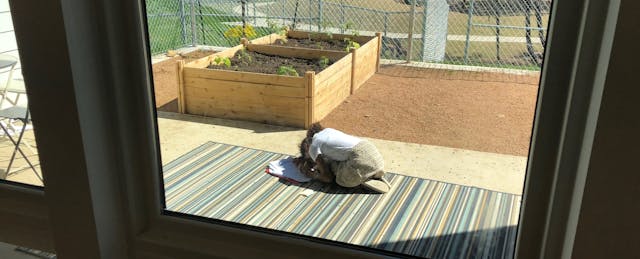As we approach the school, my Uber driver, assuming that I am looking to buy property, cautions me saying the neighborhood is dilapidated. “I wouldn’t buy or rent here. There are many abandoned homes,” he warns.
After riding past a few empty buildings, we pull up in front of what appears to be a clean, new, miniature gated-community, with small white homes inside. For a few seconds, it is unclear to me whether or not we are at the right address, but a sign facing the road that reads “Magnolia Montessori For All” tells me this is the school I am looking for.

In 2014, Sara Cotner, the founder of Magnolia Montessori For All, purposely placed her school in an economically disadvantaged part of Austin, Texas with hopes of bringing a unique model of education to a diverse community. She calls her school an intentionally “diverse by design” campus, mixing students from different socioeconomic, racial and cultural backgrounds.
“We believe that all children learn better in diverse environments, so they learn how to navigate differences in life and really help break down segregation that is plaguing our cities right now,” says Cotner.
Efforts to reduce segregation in schools have caught the attention of reporters from a number of outlets including from Vox and The Atlantic. Yet, in spite of Cotner efforts to break down segregation, demographic data from Magnolia shows that the school is increasingly becoming more wealthy.

“We try not to recruit a single upper or middle-class family, but they find us,” explains Cotner. “They try to get on our waiting list when they are pregnant. They try to rent houses in this neighborhood even though they have no intention of living here, so much privilege that we see. So we just do a lot of door-to-door to get our low-income families, our more underrepresented families, spots at the table.”
Researchers note that most diverse schools like Magnolia have trouble maintaining their diversity, saying the pendulum can often swing towards “white flight,” where white, middle-class families leave a community as students of color enter into the neighborhood, or where the reverse can occur. Michael Petrilli, executive vice president of the Fordham Institute, wrote an entire book about this swing titled “The Diverse Schools Dilemma.”
In 2014, officials from the United States Department of Education, citing a commitment to diversity in schools, tried to address the swing by making it legal for charters to issue weighted lotteries to maintain a balance between the wealthy and economically disadvantaged. However, not all states have adopted the weighted lottery system, and few school leaders have made diversity a priority—leaving the spaces continuously changing towards one demographic or the other.
The question of which direction the pendulum swings, whether towards majority white or majority students of color, may have something to do with the school model. An ongoing research study led by Dr. Mira Debs, the executive director of education studies at Yale University, has looked extensively into demographic patterns in public Montessori schools like Magnolia. She finds that the segregational pattern seen in Magnolia is indicative of a trend where upper and middle-class families push their way into public Montessori campuses, effectively gentrifying spaces originally created for a mix of communities.

“People keep reporting to me this pattern of Montessori schools that start out intentionally diverse and somewhat racially balanced becoming more and more white as they become successful,” says Debs. “A free Montessori school to some families is like honey to bees.”
In an interview with The Washington Post in 2012, Petrilli also noted that middle-class families have preferences for particular school models. “Many of the charters have uniforms and a rigid discipline code,” he said. “It’s not a culture that celebrates a lot of individualism, personal style or autonomy, the kinds of things that middle-class parents may want. So there are significant differences and cultural clashes that take place.”
These more “rigid” charter schools Petrilli describes, such as Success Academy and KIPP, have built a reputation for taking "no excuses" to close achievement gaps between wealthy and low-income families by pushing high academic expectations and regimenting behavior through things like uniforms and straight lines. Montessori charters, however, are known for pedagogical practices that encourage students to learn at their own pace, use hands-on tools and move freely through spaces. And at Cotner’s Montessori For All, she takes the concept of personalization and self-directed learning to the next level.

Cotner’s school has 500 infant through 6th-grade students in multi-age classrooms who work on various lessons depending on their individual learning goals. Teachers use a learning management system called Transparent Classroom, explicitly designed for Montessori schools, to track student mastery and provide learners with options for different lessons.
At Magnolia, classrooms look more like little neighborhood residences. Students performing activities in small backyard gardens appear unsupervised, though Cotner assures us that teachers (or “guides” as she calls them) can see students through the windows.

When we knock on the door of one home, a small boy opens it, looks up at us and smiles, indicating we can enter. Glancing around the space we see some kids sleeping in one corner, and a small girl peeling an orange in the middle of the room. Next to her, a boy and a girl are intensely focused on coloring. In the far right corner, two other students are working on tablets. There is no teacher in sight. But as we walk deeper into the home, we see a guide on the ground holding up a potted plant. She is hosting a discussion with a small group of students surrounding her. Cotner assures us that all of the children are learning something.

“You’ll see lots of practical life activities,” Cotner explains. “Lucas is grating a cinnamon stick to make a bottle of cinnamon. We are not preparing him to be a future culinary leader of America, although he might be. What we are doing in this activity is teaching him focus, concentration, how to follow multi-step directions. And he is getting delayed gratification because it is going to take him a while to make some cinnamon.”

It is indeed an unusual public-school classroom, offering students the personalization and freedom that Petrilli notes most middle-class families clamor for. Yet, according to Debs, who has conducted over 50 interviews with parents in Montessori schools, the reality of who gets to choose this type of school and what types of schools “fit” with certain groups of people are more complicated than demographic trends.
“We actually find that a lot of the parents from ‘no excuses’ schools are quite dissatisfied with the discipline, but they like the academic structure,” says Debs. “In the Montessori schools, parents are quite happy with the disciplinary structure, the freedom and respect their kids are given, but the lack of explicit academic expectations is worrisome to some parents.”
According to Debs’ research, many factors influence demographic patterns in particular school models. Geographic location can play a part in how a school’s student body is formed, but so can a parent’s academic experience. She finds that parents with a history of being educationally underserved tend to look for school options that prioritize academic success above all else—something that “no excuses” schools often emphasize. But Montessori schools tend to underplay these priorities and are known for balking at standardized tests.
“If you are from a background where you were educationally underserved, you want clear guarantees that [your kids] are going to be academically successful and that they are going to go to college,” says Debs. “That is something more of the Montessori schools don’t communicate explicitly. I think it is an expectation, but by being silent about that, there is an assumption of educational privilege.”
She describes “educational privilege” as education that is not dependent on school, noting that some wealthier parents have the finances to supplement their child’s education with things like tutoring. There also an expectation that the children of more affluent families will attend college if they want to. But this is not the case for many more impoverished families, and these differences affected how parents make school choices, says Debs.
“[A parent’s school choice sometimes] comes from what kind of education they have in their own family backgrounds,” she explains. “And how secure they are that their children are going to be achieving what they had achieved.”
It is not clear whether there are large achievement gaps between the children of wealthier parents and those of economically disadvantaged parents in the majority of Montessori schools, but Cotner acknowledged that she had observed an academic achievement gap in her school.

“Most public Montessori schools, if you dig deep enough, are perpetuating the disparities among socioeconomic lines,” says Cotner. “It gets masked because those schools tend to bring in more higher-income children, so overall you can say public Montessori [schools are] outperforming district schools. But I say, dig into the data.”
Though recently published research from Journal of Negro Schooling suggests that black students in public Montessori schools perform just as well as their peers in traditional or other magnet programs, Cotner is not satisfied with the disparities within her school. The campus currently has a below average, or 1 out of 10 rating for equity on GreatSchools, a school review website, because of the significant achievement gaps between wealthy and disadvantaged students.
Cotner says that her school is trying to do something that no other Montessori she knows of is doing, which is to maintain the purity of the model while also ensuring equitable outcomes for all children--behaviorally, socially, emotionally, and academically (including on standardized testing measures). This, she hopes, will eradicate the disparities seen along socioeconomic lines.

“We are fighting an uphill battle. People who are attracted to more progressive forms of schooling are very anti-standardized testing. If you are anti-standardized testing then you aren’t going to do whatever it takes,” says Cotner.
She notes that many students who come to her school from upper-middle-class families often already have some workplace and standardized testing skills needed to be successful. And educators from Montessori schools, mostly working with middle-class families, seem to worry less about developing these skills in students.
“At this [Montessori schooling] conference I went to, educators were like, ‘There is no curriculum, Montessori is not a curriculum. You never give a child a worksheet,'” Cotner continues. “And I am like, that is irresponsible for our disadvantaged children. It’s really hard.”
UPDATE (03/22/2018): Sara Cotner notes that other Montessori schools like City Garden Montessori School, Montessori School of Englewood, Montessori del Mundo, and Lumin Education--just to name a few--are all examples of campuses she has referenced for guidance in designing her school saying, "There is a whole movement of people and schools in the public Montessori sector striving for equitable outcomes for children."


